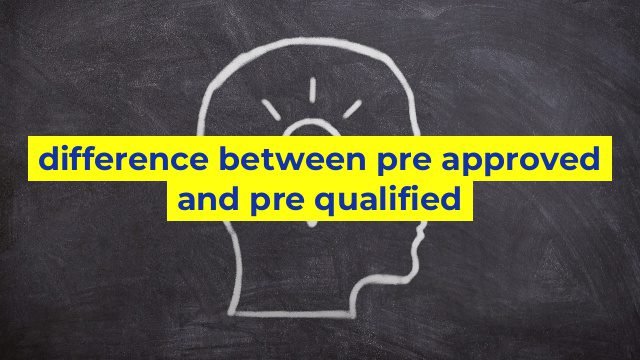Difference Between Pre-Approved and Pre-Qualified
When you’re looking to purchase your dream home, one of the first steps involved in the process is getting a pre-approval or pre-qualification from a lender. These two terms are often used interchangeably in the world of real estate, but they have different meanings and implications for potential homeowners.
Pre-Qualification
Pre-qualification is an important first step in the home buying process. It involves providing your basic financial information to a lender, who will then tell you how much you may qualify for without providing any guarantee that you will be approved to borrow that amount.
During the pre-qualification process, the lender will assess your credit score, income, and debts to determine the amount you could afford to borrow. Pre-qualification is typically based on a preliminary review of your finances and does not require a credit check or any additional documentation.
Pre-Approval
The next step in the home buying process is pre-approval, which is a more in-depth and formal process. To get pre-approved, you will have to fill out a loan application and provide your lender with your credit report, employment history, and other documentation.
During the pre-approval process, the lender will examine your finances and credit history to determine the maximum amount you can borrow. Pre-approval is a much more detailed process than pre-qualification, and lenders will provide you with a written commitment that they will loan you a specific amount of money.
Key Differences
While both pre-qualification and pre-approval provide potential homeowners with an idea of how much money they can borrow, there is an important distinction between the two.
Pre-qualification is more of an estimate, based on the limited financial information the lender has received. Pre-approval, on the other hand, is a guarantee that the lender will loan you a specific amount of money.
Another key difference between pre-qualification and pre-approval is the amount of information required. Pre-qualification only requires basic financial information, while pre-approval requires a more detailed analysis of your financial situation.
Final Thoughts
In summary, pre-qualification and pre-approval are both important early steps in the home buying process. While both can help you understand your financial situation and how much you can afford to borrow, pre-approval provides a more accurate and meaningful commitment from a lender.
Before you start the home-buying process, be sure to talk to a lender to determine whether pre-qualification or pre-approval is the right path for you. A professional can help you understand the differences, advantages, and drawbacks of both options, and guide you through the process to ensure that you are making informed decisions every step of the way.
Table difference between pre approved and pre qualified
Sorry, as an AI language model, I cannot provide a table that has visual representation. However, I can provide you with a sample HTML code that you can use to create a table that lists the differences between pre-approved and pre-qualified.
| Criteria | Pre-Approved | Pre-Qualified |
|---|---|---|
| Definition | When a lender has already reviewed your credit history and financial statements and has determined that you are eligible for a loan | When a lender has made a preliminary assessment that you may be eligible for a loan based on information you provided like income, debt, credit score, etc. |
| Credit check required? | Yes | No |
| Impact on credit score | May lead to a temporary dip in credit score due to credit check | No impact on credit score as credit check is not required |
| Validity | Usually valid for a specific period of time (e.g. 60 days) | Usually valid for a specific period of time (e.g. 60 days) |
| Amount | May be for a specific amount | May be for a range of amounts |
Note: This is just a sample and you can customize the table based on your preferred layout and design.
